用戶:Misaka1366/沙盒
施工草稿區
[編輯]詳細經過
[編輯]| 時間 (UTC+8) | 事件 | 備註 |
|---|---|---|
| 2021年4月29日 11時23分 |
天和核心艙升空 | 搭載空間站天和核心艙的長征五號B遙二運載火箭在文昌航天發射場點火升空。11時31分,天和核心艙與火箭成功分離,進入預定軌道。12時36分,太陽能帆板兩翼順利展開且工作正常,發射任務取得成功,中國空間站在軌組裝建造全面展開。[1] |
| 5月29日 20時55分 |
天舟二號升空 | [2][3] |
| 6月17日 9時22分 |
神舟12號發射 | 乘組:聶海勝、劉伯明、湯洪波 天宮空間站首次航天員進駐[4][5][6] |
| 6月17日 15時54分 |
神舟12號成功與天和核心艙核心艙前向端口對接 | 首次在載人任務中進行6.5小時快速交會對接[7][5][8] |
| 6月17日 18時48分 |
神舟12號乘組成功進入天和核心艙 | [9][5][10] |
| 7月4日 14時57分 |
首次出艙活動 | 出艙人員:劉伯明 、湯洪波[11] |
| 8月2日 8時38分 |
第二次出艙活動 | 出艙人員:劉伯明 、聶海勝[12] |
| 9月23日 | 霍爾電推進子系統在軌點火測試 | 首次在載人航天器上使用霍爾推進器[13] |
 Illustration of DART mission in space just before impact | |
| 名稱 | DART |
|---|---|
| 任務類型 | Planetary defense mission |
| 運營方 | NASA / APL |
| 國際衛星標識符 | 2021-110A |
| 衛星目錄序號 | 49497 |
| 網站 | nasa.gov/planetarydefense/dart dart |
| 任務時長 | 11 months (planned) 1137天18小時 (in progress) |
| 航天器屬性 | |
| 航天器 |
|
| 航天器類型 | Double Asteroid Redirection Test |
| 平台 | DART |
| 製造方 | Applied Physics Laboratory of Johns Hopkins University |
| 發射質量 | DART: 610公斤(1,340磅), LICIACube: 14公斤(31磅) |
| 尺寸 | DART: 1.8乘1.9乘2.6米(5英尺11英寸乘6英尺3英寸乘8英尺6英寸) ROSA: 8.5乘2.4米(27.9乘7.9英尺) (each) |
| 功率 | 6.6 kW |
| 任務開始 | |
| 發射日期 | 24 November 2021, 06:21:02 UTC |
| 運載火箭 | Falcon 9 Block 5, B1063.3 |
| 發射場 | Vandenberg, SLC-4E |
| 承包方 | SpaceX |
| Dimorphos撞擊器 | |
| 撞擊日期 | 26 September 2022 (planned) |
| 搭載儀器 | |
| Didymos Reconnaissance and Asteroid Camera for Optical navigation (DRACO) | |
 DART mission patch | |

Double Asteroid Redirection Test (DART) is a NASA space mission aimed at testing a method of planetary defense against near-Earth objects (NEO). It will deliberately crash a space probe into the double asteroid Didymos' moon, Dimorphos, to test how the momentum of a spacecraft impact could successfully deflect an asteroid on a collision course with Earth. DART is a joint project between NASA and the Johns Hopkins Applied Physics Laboratory (APL), administered by NASA's Planetary Defense Coordination Office, with several NASA laboratories and offices providing technical support. International partners, such as the space agencies of Europe, Italy, and Japan, are contributing to related or subsequent projects. In August 2018, NASA approved the project to start the final design and assembly phase. DART was launched on 24 November 2021, at 06:21:02 UTC, with collision slated for 26 September 2022.[14][15]
Description
[編輯]

DART · 65803 Didymos · Earth · Sun · 2001 CB21 · 3361 Orpheus
DART是一個重達610公斤的撞擊器,[16] 除了必要的星敏感器,太陽追蹤器以及一個20厘米大的相機(Didymos Reconnaissance and Asteroid Camera for Optical navigation – DRACO)外沒有任何科學載荷,DARCO是基於新視野號上的LORRI設計的,以保證其在撞擊小行星迪迪莫斯前進行自動導航。[來源請求]
一個重達500公斤的DART以6.6千米每秒的速度撞擊迪迪莫斯[17] DART at 6.6 km/s(4.1 mi/s) [18][19] 可以給該衛星提供一個0.4 mm/s的△V。[20][21][22][23] 撞擊目標點位於小行星迪迪莫斯的中心,這會使其11.92小時的公轉周期縮短約10分鐘[16] 這一微小的改變會隨着時間的推移被不斷放大,從而降低近地小行星撞擊地球的風險。[24]
實際撞擊對小行星的飛行速度以及其軌道的影響有很大的不確定性,因為人們對由於撞擊拋射物帶來的反衝力缺乏了解。 根據推測,撞擊給小行星帶來的動量將會是撞擊器本身的3-5倍,通過精確測量,我們可以針對此類撞擊構建出更加精確的模型,這也是任務的一大目標[25] Initial estimates of the change in binary orbit period should be known within a week.[26] Details will be measured a few years later by a spacecraft called Hera that would do a detailed reconnaissance and assessment.[27] Hera was approved in November 2019.[28]
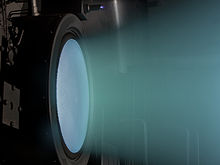


DART採用了一種名為NEXT(NASA Evolutionary Xenon Thruster–Commercial)的光-電離子推進系統.[29][30] 其所需的3.5千瓦的電力將由一塊面積為22平方米的太陽能板提供[31]
探測器的太陽能板採用捲軸式設計(ROSA - Roll Out Solar Array),這種設計以及在國際太空站上與2017年 Space-X CRS11任務期間完成驗證[32]
Using ROSA as the structure, a small portion of the DART solar array is configured to demonstrate Transformational Solar Array technology, which has very-high-efficiency solar cells and reflective concentrators providing three times more power than current solar array technology.通過採用這種結構[33][34]
DART是第一款採用新型高增益天線技術(RLSA - Spiral Radial Line Slot Array)的探測器,這種天線工作於NASA深空網絡的X波段(7.2-8.4GHZ)。這種柔性天線的性能超出了此次任務的技術需求,同時該技術經過驗證,被認為達到了TRL-6標準(Technology Readiness Level)[35]
Secondary spacecraft
[編輯]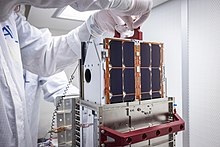
The Italian Space Agency (ASI) will contribute a secondary spacecraft called LICIACube (Light Italian CubeSat for Imaging of Asteroids), a small CubeSat that will piggyback with DART and will separate 10 days before impact to acquire images of the impact and ejecta as it drifts past the asteroid.[27][36] LICIACube will communicate directly with Earth, sending back images of the ejecta after the Dimorphos flyby.[37] LICIACube is equipped with two optical cameras, dubbed LUKE and LEIA.[來源請求]
意大利宇航局 (ASI)將會參與到一個名為LICIACube的子探測器計劃中,這是一個將會被安裝在DART上的小型立方體探測器。LICIACube將會在撞擊前10日與主探測器DART分離,以便留出足夠的距離使得其在飛躍小行星迪迪莫斯期間可以對撞擊產生的拋射物進行完整拍攝[27][36]
Follow-up mission
[編輯]In a collaborating project, the European Space Agency is developing Hera, a spacecraft that will be launched to Didymos in 2024 [38] and arrive in 2027[39] — 5 years after DART's impact — to do a detailed reconnaissance and assessment.[38] Hera would carry two CubeSats, Milani and Juventas.[38]
AIDA mission architecture
[編輯]Mission profile
[編輯]Target asteroid
[編輯]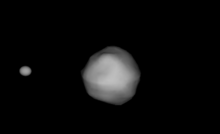
The mission's target is Dimorphos in 65803 Didymos system, a binary asteroid system in which one asteroid is orbited by a smaller one. The primary asteroid (Didymos A) is about 780米(2,560英尺) in diameter; its small satellite Dimorphos (Didymos B) is about 160米(520英尺) in diameter in an orbit about 1 km(0.62 mi) from the primary.[29] The mass of the Didymos system is estimated at 528 billion kg, with Dimorphos at 4.8 billion kg.[16] DART will target the smaller asteroid, Dimorphos. Didymos is not an Earth-crossing asteroid, and there is no possibility that the deflection experiment could create an impact hazard.[22]
Preflight preparations
[編輯]



Launch preparations for DART began on 20 October 2021, as the spacecraft began fueling at Vandenberg Space Force Base in California.[40] The spacecraft arrived at Vandenberg Space Force Base (VSFB) near Lompoc, in early October after a cross-country drive. DART team members have since been preparing the spacecraft for flight, testing the spacecraft's mechanisms and electrical system, wrapping the final parts in multilayer insulation blankets, and practicing the launch sequence from both the launch site and the mission operations center at APL. DART headed to the SpaceX Payload Processing Facility on VSFB on 26 October 2021. Two days later, the team received the green light to fill DART's fuel tank with roughly 50公斤(110磅) of hydrazine propellant for spacecraft maneuvers and attitude control. DART also carries about 60公斤(130磅) of xenon for the NEXT-C ion engine. Engineers loaded the xenon before the spacecraft left APL in early October 2021.[41]
Starting on 10 November 2021, engineers "mated" the spacecraft to the adapter that stacks on top of the SpaceX Falcon 9 launch vehicle. The Falcon 9 rocket without the payload fairing rolled for a static fire and later came back to the processing facility again where technicians with SpaceX installed the two halves of the fairing around the spacecraft over the course of two days, November 16 and 17, inside the SpaceX Payload Processing Facility at Vandenberg Space Force Base in California and the ground teams completed a successful Flight Readiness Review later that week with the fairing then attached to the rocket.[42]
A day before launch, the launch vehicle rolled out of the hangar and onto the launch pad at Vandenberg Space Launch Complex 4 (SLC-4E), where it propeled the spacecraft into space and kick off DART's journey to the Didymos system.[41]
Launch
[編輯]The DART spacecraft was launched on 24 November 2021, at 06:21:02 UTC.
Early planning suggested that DART was planned to be deployed into a high altitude, high eccentricity Earth orbit that is designed to avoid the Moon. In such a scenario, DART would use its low thrust, high efficiency NEXT ion engine to slowly escape from its high Earth orbit to a slightly inclined near-Earth solar orbit, from which it would maneuver onto a collision trajectory with its target. But because this is a dedicated Falcon 9 mission, the payload along with Falcon 9's second stage was placed directly on an Earth escape trajectory and into heliocentric orbit when the second stage reignited for a second engine startup or escape burn. Thus, although DART carries a first-of-its-kind electric thruster and plenty of xenon fuel, Falcon 9 did almost all of the work, leaving the spacecraft to perform only a few trajectory-correction burns with simple chemical thrusters as it homes in on Didymos's moon Dimorphos.[43]
Gallery
[編輯]-
DART in Didymos system
-
DART Mission animated video from launch to impact along with separation of LICIACube
-
DART's impact schedule
-
Infographic showing the effect of DART's impact on the orbit of Didymos B while deployment of Italian LICIACube
-
Dart's ion thrusters
-
The installation of ROSA on DART
-
The recently installed Roll-Out Solar Arrays (ROSA) on DART mission
-
Nancy Chabot and Andy Rivkin, researchers at Johns Hopkins University Applied Physics Laboratory, are pictured with the DART spacecraft.
-
LICIACube CubeSat integrated on DART spacecraft
-
LICIACube CubeSat integrating on DART spacecraft
-
DART at Vandenberg Space Force Base
-
DART being given launch readiness review
-
DART processing
-
DART mating to payload adapter
-
DART processed at SpaceX payload Processing Facility at VSFB, SLC-4E launch site
-
DART fueled at SpaceX payload Processing Facility at VSFB
-
DART spacecraft are being readied for launch, on 24 November 2021
-
Falcon 9 rocket and DART spacecraft are being readied for launch
-
DART moving to Launch Pad
-
DART going to launch pad
-
Launch pad of DART
-
DART arrives at launch pad
See also
[編輯]- Asteroid impact avoidance
- B612 Foundation
- Don Quijote (spacecraft)
- NEOCam
- Planetary defense against asteroids and comets
- The Spaceguard Foundation
References
[編輯]- ^ 空间站天和核心舱飞行任务新闻发布会召开. 中國載人航天官方網站. 2021-04-29 [2021-07-13]. (原始內容存檔於2021-07-13).
- ^ 天舟二号货运飞船发射任务取得圆满成功. 中國載人航天. 2021-05-29 [2021-07-13]. (原始內容存檔於2021-07-13).
- ^ 天舟二号货运飞船与天和核心舱完成自主快速交会对接. 中國載人航天. 2021-05-29 [2021-07-13]. (原始內容存檔於2021-07-13).
- ^ 神舟十二号载人飞船发射圆满成功. 中國載人航天. 2021-06-17 [2021-06-17]. (原始內容存檔於2021-06-17).
- ^ 5.0 5.1 5.2 神舟十二号载人飞船与天和核心舱完成自主快速交会对接. 中國載人航天. 2021-06-17 [2021-07-13]. (原始內容存檔於2021-06-29).
- ^ 神舟十二号3名航天员顺利进驻天和核心舱. 中國載人航天. 2021-06-17 [2021-07-13]. (原始內容存檔於2021-06-30).
- ^ 神舟十二号载人飞船发射圆满成功. 中國載人航天. 2021-06-17 [2021-06-17]. (原始內容存檔於2021-06-17).
- ^ 神舟十二号3名航天员顺利进驻天和核心舱. 中國載人航天. 2021-06-17 [2021-07-13]. (原始內容存檔於2021-06-30).
- ^ 神舟十二号载人飞船发射圆满成功. 中國載人航天. 2021-06-17 [2021-06-17]. (原始內容存檔於2021-06-17).
- ^ 神舟十二号3名航天员顺利进驻天和核心舱. 中國載人航天. 2021-06-17 [2021-07-13]. (原始內容存檔於2021-06-30).
- ^ 中國太空站太空人相隔40多天再出艙 將完成三項任務. Now TV. 2021-08-20 [2021-08-20]. (原始內容存檔於2021-08-20).
- ^ 神舟十二号航天员乘组圆满完成空间站阶段首次出舱活动全部既定任务. 中國載人航天. 2021-07-04 [2021-07-13]. (原始內容存檔於2021-07-09).
- ^ 航天六院801所十年磨一剑 空间站电推进系统成功首秀. 中國航天科技集團六院. 2021-09-26 [2021-09-26].
- ^ SpaceX ready for first launch with NASA interplanetary mission. Spaceflight Now. 22 November 2021 [24 November 2021].
- ^ DART Launch Moves to Secondary Window. NASA. 17 February 2021 [24 November 2021].
 本文含有此來源中屬於公有領域的內容。
本文含有此來源中屬於公有領域的內容。
- ^ 16.0 16.1 16.2 Double Asteroid Redirection Test (DART). NASA. 28 October 2021 [5 November 2021].
 本文含有此來源中屬於公有領域的內容。
本文含有此來源中屬於公有領域的內容。
- ^ DART: Home page at APL 互聯網檔案館的存檔,存檔日期2018-05-10. DART Spacecraft APL 2017
- ^ Impactor Spacecraft. NASA. 2021 [18 February 2021].
 本文含有此來源中屬於公有領域的內容。
本文含有此來源中屬於公有領域的內容。
- ^ Andone, Dakin. NASA unveils plan to test asteroid defense technique. CNN. July 25, 2017 [July 25, 2017].
- ^ Cheng, A.F.; Michel, P.; Reed, C.; Galvez, A.; Carnelli, I. DART: Double Asteroid Redirection Test (PDF). European Planetary Science Congress 2012. EPSC Abstracts. 2012.
- ^ 引用錯誤:沒有為名為
Aida study 20153的參考文獻提供內容 - ^ 22.0 22.1 Michel, P.; Cheng, A.; Carnelli, I.; Rivkin, A.; Galvez, A.; Ulamec, S.; Reed, C.; AIDA Team. AIDA: Asteroid impact and deflection assessment mission under study at ESA and NASA. Spacecraft Reconnaissance of Asteroid and Comet Interiors. 8 January 2015, 1829: 6008. Bibcode:2015LPICo1829.6008M.
- ^ Course corrector Adam Hadhazy Aerospace America October 2017
- ^ NASA Pushes Through With Asteroid Deflection Mission That Could One Day Save Earth The Inquisitr 5 July 2017
- ^ Rivkin, Andrew S.; Chabot, Nancy L.; Stickle, Angela M.; Thomas, Cristina A.; Richardson, Derek C.; Barnouin, Olivier; Fahnestock, Eugene G.; Ernst, Carolyn M.; Cheng, Andrew F.; Chesley, Steven; Naidu, Shantanu. The Double Asteroid Redirection Test (DART): Planetary Defense Investigations and Requirements. The Planetary Science Journal. 2021-08-25, 2 (5): 173. ISSN 2632-3338. doi:10.3847/PSJ/ac063e.
- ^ DART: Asteroid - eoPortal Directory - Satellite Missions. directory.eoportal.org. [2021-11-24].
- ^ 27.0 27.1 27.2 Asteroids have been hitting the Earth for billions of years. In 2022, we hit back. 互聯網檔案館的存檔,存檔日期2018-10-31. Andy Rivkin, The Johns Hopkins University Applied Physics Laboratory September 27, 2018
- ^ Hera mission is approved as ESA receives biggest ever budget Kerry Hebden Room Space Journal 29 November 2019
- ^ 29.0 29.1 Planetary Defense: Double Asteroid Redirection Test (DART) Mission NASA 2017
 本文含有此來源中屬於公有領域的內容。
本文含有此來源中屬於公有領域的內容。
- ^ Kantsiper, Brian. The Double Asteroid Redirection Test (DART) mission electric propulsion trade. 2017 IEEE Aerospace Conference. 2017: 1–7. ISBN 978-1-5090-1613-6. S2CID 43072949. doi:10.1109/AERO.2017.7943736.
- ^ Adams, Elena; Oshaughnessy, Daniel; Reinhart, Matthew; John, Jeremy; Congdon, Elizabeth; Gallagher, Daniel; Abel, Elisabeth; Atchison, Justin; Fletcher, Zachary; Chen, Michelle; Heistand, Christopher; Huang, Philip; Smith, Evan; Sibol, Deane; Bekker, Dmitriy; Carrelli, David. Double Asteroid Redirection Test: The Earth Strikes Back. 2019 IEEE Aerospace Conference. 2019: 1–11. ISBN 978-1-5386-6854-2. S2CID 195222414. doi:10.1109/AERO.2019.8742007.
- ^ Talbert, Tricia. Double Asteroid Redirection Test (DART) Mission. NASA. 2017-06-30 [2018-01-21].
 本文含有此來源中屬於公有領域的內容。
本文含有此來源中屬於公有領域的內容。
- ^ Behind the Scenes: Inspecting DART's Roll-Out Solar Array (ROSA) Technology, [2021-08-13]
- ^ DART has a solar array experiment called transformational solar array on its roll out solar array panel. dart.jhuapl.edu. [2021-08-13].
- ^ Bray, Matthew. A Spiral Radial Line Slot Array Antenna for NASA's Double Asteroid Redirection Test (DART). 2020 IEEE International Symposium on Antennas and Propagation and North American Radio Science Meeting. 2020: 379–380. ISBN 978-1-7281-6670-4. S2CID 231975847. doi:10.1109/IEEECONF35879.2020.9330400.
- ^ 36.0 36.1 Kretschmar, Peter; Küppers, Michael. The CubeSat Revolution (PDF). ESA. 20 December 2018 [2019-01-24].
- ^ Cheng, Andy. DART Mission Update (PDF). ESA. 15 November 2018 [2019-01-14].
- ^ 38.0 38.1 38.2 Bergin, Chris. Hera adds objectives to planetary defense test mission. NASASpaceflight.com. January 7, 2019 [2019-01-11].
- ^ The Juventas CubeSat in Support of ESA's Hera Mission to the Asteroid Didymos. Hannah R. Goldberg, Özgür Karatekin, Birgit Ritter, Alain Herique, Paolo Tortora, Claudiu Prioroc, Borja Garcia Gutierrez, Paolo Martino, Ian Carnelli. 33rd Annual AIAA/USU Conference on Small Satellites.
- ^ Spacecraft for asteroid deflection experiment ready for fueling at Vandenberg. Spaceflight Now. October 20, 2021 [November 5, 2021].
- ^ 41.0 41.1 NASA's DART Preps for Launch in First Planetary Defense Test Mission. NASA. 2021-11-03 [2021-11-24].
 本文含有此來源中屬於公有領域的內容。
本文含有此來源中屬於公有領域的內容。
- ^ NASA's DART Spacecraft Secured In Payload Fairing, Flight Readiness Review Complete – Double Asteroid Redirection Test (DART) Mission. blogs.nasa.gov. [2021-11-24].
 本文含有此來源中屬於公有領域的內容。
本文含有此來源中屬於公有領域的內容。
- ^ Atchison, Justin A.; Ozimek, Martin T.; Kantsiper, Brian L.; Cheng, Andrew F. Trajectory options for the DART mission. Acta Astronautica. Special Section: Selected Papers from the International Workshop on Satellite Constellations and Formation Flying 2015. 2016-06-01, 123: 330–339. Bibcode:2016AcAau.123..330A. ISSN 0094-5765. doi:10.1016/j.actaastro.2016.03.032.
External links
[編輯]- Double Asteroid Redirection Test (DART) Mission – NASA's Planetary Defense page on DART
- DART’s Mission to Bump an Asteroid – NASA Blog
- NASA's DART Mission Launch, 2021-11-24 – Official Broadcast/Stream
Template:Asteroid spacecraft Template:Falcon rocket launches Template:Orbital launches in 2021 Template:2021 in space
History
[編輯]Reported cases
[編輯]On 24 November 2021, the variant was first reported to the WHO from South Africa.[1] The first known specimen was collected on 9 November 2021 from Botswana.[2] It was also detected in South Africa;[3] one case had traveled to Hong Kong,[4][5] and one confirmed case was identified in Israel in a traveler returning from Malawi,[6] along with two who returned from South Africa and one from Madagascar.[7] One confirmed case in Belgium had apparently acquired it in Egypt before 11 November.[8]
All four initial cases reported from Botswana occurred among fully vaccinated individuals.[9] All three initial confirmed and suspected cases reported from Israel occurred among fully vaccinated individuals,[6] as did the single suspected case in Germany.[10]
On 27 November, two cases were detected in the United Kingdom, another two in Munich, Germany and one in Milan, Italy.[11] The Dutch health ministry estimated that 61 of the around 600 passengers on two flights from South Africa that had landed at Amsterdam Airport Schiphol on 26 November (which had taken off just before the Netherlands had banned travel from South Africa) tested positive for COVID-19 of as yet unknown variants. Entry into the Netherlands (and thus getting on the flight) generally required having been vaccinated or PCR-tested, or having recovered. One of the flights originated from Johannesburg, Gauteng. Gauteng is where the Omicron variant appears to be dominant already. The passengers of both flights had been tested and quarantined upon arrival because of the newly imposed restrictions.[12]
On 28 November, two cases were detected in Sydney, Australia. Both people landed in Sydney the previous day, and have travelled from southern Africa to Sydney via Doha, Qatar. The two people, who are fully vaccinated, entered isolation; 12 other travellers from southern Africa also entered quarantine for fourteen days, while about 260 other passengers and crew on the flight have been directed to isolate.[13]
Crew
[編輯]| 崗位 | Astronaut | |
|---|---|---|
| Commander | 第Sixth and last次飛行 | |
| Pilot | 第First次飛行 | |
| Mission Specialist 1 | 第Second and last次飛行 | |
| Mission Specialist 2 | 第First次飛行 | |
| Payload Specialist 1 | 第First次飛行 | |
| Payload Specialist 2 | 第First次飛行 | |
Backup crew
[編輯]| 崗位 | Astronaut | |
|---|---|---|
| Payload Specialist 1 | ||
| Payload Specialist 2 | ||
Support crew
[編輯]- John E. Blaha (entry CAPCOM)
- Franklin R. Chang-Diaz
- Mary L. Cleave
- Anna L. Fisher
- William F. Fisher
- Guy S. Gardner (ascent CAPCOM)
- Chuck Lewis (Marshall CAPCOM)
- Bryan D. O'Connor
- Wubbo Ockels
Crew seating arrangements
[編輯]| Seat[14] | Launch | Landing | 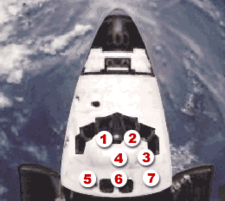 Seats 1–4 are on the Flight Deck. Seats 5–7 are on the Middeck. |
|---|---|---|---|
| S1 | Young | Young | |
| S2 | Shaw | Shaw | |
| S4 | Parker | Parker | |
| S5 | Garriott | Garriott | |
| S6 | Lichtenberg | Lichtenberg | |
| S7 | Merbold | Merbold |
任務背景
[編輯]STS-9的7人機組是當時人數最多的載人航天任務,其中包括指令長John W. Young(第二次進入太空); 飛行員 Brewster H. Shaw;任務專家 Owen Garriott 和 Robert A. Parker; 載荷專家 Byron K. Lichtenberg(來自麻省理工大學的科研者),Ulf Merbold(西德,第一位乘坐穿梭機的非美國籍太空人),他們是最早的兩位乘坐穿梭機進入太空且不屬於NASA的太空人. Prior to STS-9, the scientist-astronaut Garriott had spent 56 days in orbit in 1973 aboard Skylab. Commanding the mission was veteran astronaut John Young, making his sixth and final flight over an 18-year career that saw him fly twice each in Gemini, Apollo, and the Shuttle, which included two journeys to the Moon and making him the most experienced space traveler to date. Young, who also commanded Columbia on its maiden voyage STS-1, was the first person to fly the same space vehicle into orbit more than once. STS-9 marked the only time that two pre-Shuttle era astronaut veterans (Garriott and Young) would fly on the same Space Shuttle mission.
The mission was devoted entirely to Spacelab 1, a joint NASA/European Space Agency (ESA) program designed to demonstrate the ability to conduct advanced scientific research in space. Both the mission specialists and payload specialists worked in the Spacelab module and coordinated their efforts with scientists at the Marshall Payload Operations Control Center (POCC), which was then located at the Johnson Space Center in Texas. Funding for Spacelab 1 was provided by the ESA.
Shuttle processing
[編輯]After Columbia's return from STS-5 in November 1982, it received several modifications and changes in preparation for STS-9. Most of these changes were intended to support the Spacelab module and crew, such as the addition of a tunnel connecting the Spacelab to the orbiter's airlock, and additional provisions for the mission's six crew members, such as a galley and sleeping bunks. Columbia also received the more powerful Space Shuttle Main Engines introduced with Challenger, which were rated for 104% maximum thrust; its original main engines were later refurbished for use with Atlantis, which was still under construction at the time. Also added to the shuttle were higher capacity fuel cells and a Ku-band antenna for use with the Tracking and Data Relay Satellite (TDRS).[15]
The mission's original launch date of October 29, 1983 was scrubbed due to concerns with the exhaust nozzle on the right solid rocket booster (SRB). For the first time in the history of the shuttle program, the shuttle stack was rolled back to the Vehicle Assembly Building (VAB), where it was destacked and the orbiter returned to the Orbiter Processing Facility, while the suspect booster underwent repairs. The shuttle was restacked and returned to the launch pad on November 8, 1983.[15][16][17]
Mission summary
[編輯]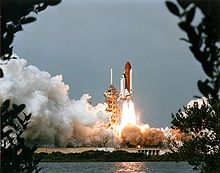
STS-9 launched successfully from Kennedy Space Center at 11 am EST on November 28, 1983.
The shuttle's crew was divided into two teams, each working 12-hour shifts for the duration of the mission. Young, Parker and Merbold formed the Red Team, while Shaw, Garriott and Lichtenberg made up the Blue Team. Usually, Young and Shaw were assigned to the flight deck, while the mission and payload specialists worked inside the Spacelab.
Over the course of the mission, 72 scientific experiments were carried out, spanning the fields of atmospheric and plasma physics, astronomy, solar physics, material sciences, technology, astrobiology and Earth observations. The Spacelab effort went so well that the mission was extended an additional day to 10 days, making it the longest-duration shuttle flight at that time. In addition, Garriott made the first ham radio transmissions by an amateur radio operator in space during the flight. This led to many further space flights incorporating amateur radio as an educational and back-up communications tool.
The Spacelab 1 mission was highly successful, proving the feasibility of the concept of carrying out complex experiments in space using non-NASA persons trained as payload specialists in collaboration with a POCC. Moreover, the TDRS-1 satellite, now fully operational, was able to relay significant amounts of data through its ground terminal to the POCC.
During orbiter orientation, four hours before re-entry, one of the flight control computers crashed when the RCS thrusters were fired. A few minutes later, a second crashed in a similar fashion, but was successfully rebooted. Young delayed the landing, letting the orbiter drift. He later testified: "Had we then activated the Backup Flight Software, loss of vehicle and crew would have resulted." Post-flight analysis revealed the GPCs (General Purpose Computers)[18] failed when the RCS thruster motion knocked a piece of solder loose and shorted out the CPU board. A GPC running BFS may or may not have the same soldering defect as the rest of the GPCs. Switching the vehicle to the BFS from normal flight control can happen relatively instantaneously, and that particular GPC running the BFS could also be affected by the same failure due to the soldering defect. If such a failure occurred, switching the vehicle back to normal flight control software on multiple GPCs from a single GPC running BFS takes a lot longer, in essence leaving the vehicle without any control at all during the change.
Columbia landed on Runway 17 at Edwards Air Force Base on December 8, 1983, at 3:47 pm PST, having completed 166 orbits and travelled 4.3 × 106英里(6.9 × 106公里) over the course of its mission. Right before landing, two of the orbiter's three auxiliary power units caught fire due to a hydrazine leak, but the orbiter nonetheless landed successfully. Columbia was ferried back to KSC on December 15. The leak was later discovered after it had burned itself out and caused major damage to the compartment. The shuttle was then sent off for an extensive renovation and upgrade program to bring it up to date with the newer Challenger orbiter as well as the upcoming Discovery and Atlantis. As a result, Columbia would not fly at all during 1984–85.
Launch attempts
[編輯]Mission insignia
[編輯]The mission's main payload, Spacelab 1, is depicted in the payload bay of the Columbia. The nine stars and the path of the orbiter indicate the flight's numerical designation, STS-9.
See also
[編輯]- List of human spaceflights
- List of Space Shuttle missions
- List of spaceflight-related accidents and incidents
References
[編輯]- ^ 引用錯誤:沒有為名為
who-statement的參考文獻提供內容 - ^ Callaway, Ewen. Heavily mutated coronavirus variant puts scientists on alert. Nature. 25 November 2021. PMID 34824381. doi:10.1038/d41586-021-03552-w (英語).
- ^ Lineage: Mutation Tracker: s:S371L Mutation Report. outbreak.info. [26 November 2021] (英語).
- ^ Covid: New heavily mutated variant B.1.1.529 in South Africa raises concern, 25 November 2021, BBC News, accessed 25 November 2021
- ^ Tracking SARS-CoV-2 variants (Tables: Currently designated Variants Under Monitoring -describes 529 variant as present in 'Multiple countries'- and 'Formerly monitored variants'- B.1.523 & B.1.619 Reclassified Nov 2021). www.who.int, accessed 25 November 2021
- ^ 6.0 6.1 @BNODesk. Statement from Israel's health ministry reporting 1 confirmed case of new coronavirus variant B.1.1.529 (推文). 26 November 2021 [26 November 2021] –透過Twitter.
- ^ 14:30 4 מאומתים לווריאנט החדש התגלו בארץ, רה"מ יקיים מסיבת עיתונאים translated: "...Verified for the new strain 4 verified for the new variant were discovered in the country...", m.ynet.co.il, accessed 26 November 2021
- ^ Reuters. Belgium detects first case of new COVID-19 variant in Europe. Reuters. 26 November 2021 [26 November 2021] (英語).
- ^ Four cases of the new COVID-19 variant recorded in Botswana, 25 November 2021, Mmegi Online, accessed 26 November 2021
- ^ Kerstin Kesselgruber. Flughafen Frankfurt: Person mit Omikron-Verdacht war vollständig geimpft [Frankfurt airport: Person suspected to be infected with omicron variant was fully vaccinanted]. Frankfurter Rundschau. 27 November 2021 [27 November 2021]. (原始內容存檔於27 November 2021) (德語).
- ^ UK, Germany and Italy detect Omicron coronavirus variant cases. Reuters. 27 November 2021 [27 November 2021].
- ^ 61 travellers from South Africa in Netherlands positive for COVID-19 -authorities. Reuters (Amsterdam). 27 November 2021 [27 November 2021].
- ^ Travellers test positive to Omicron COVID-19 strain after arriving in Sydney from southern Africa, NSW Health says. ABC News. 2021-11-28 [2021-11-28].
- ^ STS-9. Spacefacts. [February 26, 2014].
- ^ 15.0 15.1 STS-9 Press Kit (PDF). NASA. [April 26, 2013].
- ^ Lewis, Richard. The voyages of Columbia: the first true spaceship
 . Columbia University Press. 1984: 204. ISBN 978-0-231-05924-4.
. Columbia University Press. 1984: 204. ISBN 978-0-231-05924-4.
- ^ Shuttle Rollbacks. NASA. [April 26, 2013].
- ^ Space Shuttle DATA PROCESSING SYSTEM Manual; Interior of the Flight Deck of the Space Shuttles.
Further reading
[編輯]- Long, Michael E. Spacelab 1. National Geographic. Vol. 164 no. 3. September 1983: 301–307. ISSN 0027-9358. OCLC 643483454.
External links
[編輯]- STS-9 mission summary. NASA.
- STS-9 video highlights. NSS.
- Neumann, Peter G. Space shuttle computer problems, 1981–1985. The Risks Digest. January 20, 1989, 8 (13) [July 20, 2013].
Template:Space Shuttle Columbia Template:All U.S. Space Shuttle Missions Template:Orbital launches in 1983
2020年
[編輯]美國太空軍公佈,長征五號B火箭芯一級在完成任務後於2020年5月11日在大西洋上空脫離軌道,於北京時間5月12日晚23時33分再入靠近非洲西海岸。芯一級繞行地球達102圈。[1]有報道指一片12米殘骸就墜落在科特迪瓦馬洪努村,損毀了一些建築物,但沒有受傷的報道。[2][3][4]美國太空總署(NASA)局長吉姆·布里登斯廷對火箭於大西洋再入前不到一小時飛越了美國大都會區而批評:「它飛過了人口中心,並重新進入了地球大氣層。這可能是非常危險的",[5][6],並指這有悖NASA正尋求太空活動行為規範《阿爾忒彌斯協定》的一切原則[7]。
2021年
[編輯]長征五號B遙二芯一級殘骸於2021年5月9日北京時間10時15分在阿拉伯半島上空再入大氣層,[8]10時24分落入印度洋馬爾代夫國領海上,具體為Kudahuvadhoo島西南45公里。[9]馬爾代夫國防軍海防分艦隊收到民眾反映後已巡查。[9]中國官方公佈落點為位於東經72.47°北緯2.65°,並指絕大部分器件在再入大氣層過程中燒蝕銷毀。[10]由於再入點在阿拉伯半島,引起當地民眾觀測。[8]
國際媒體不少以『中國的「航天事故」』為題報導,[11][12][13]並與另外兩次墜落事故比較:1979年7月12日美國太空總署的天空實驗室計劃(Skylab)墜落西澳洲埃斯佩蘭斯鎮、1977年蘇聯發射的宇宙954號墜落在加拿大[14][15][16][17]。此次長征五號B運載火箭的第一級殘骸被認爲是有史以來第四重的無控殘骸。[11]
各國機構反響
[編輯]- 美國太空總署局長比爾·納爾遜:「航天國家必須儘量減少太空物體再次進入地球對人和財產的風險,並最大限度地提高這些行動的透明度」「很明顯,中國在其空間碎片方面沒有達到負責任的標準」「至關重要的是,中國和所有航天國家和商業實體在太空中採取負責任和透明的行動,以確保外層空間活動的安全、穩定、安保和長期可持續性。」[18]
- 歐洲空間局(ESA)空間運行中心工程與創新部門負責人Nicolas Brobrinsky呼籲進行監管和變更長征5號火箭的模塊,否則相同問題將再次出現。Nicolas Brobrinsky評論:「基於長征五號的殘骸的質量約為18噸,我們確實有點擔心其落點的確切位置,但最終一切順利,沒有任何損害。正如預期的那樣,大部分的火箭段在大氣層中燒毀了,每個人都鬆了一口氣。」「我們必須從這個事件中學習,當知道火箭不會徹底解體時,應該通過聯合國等途徑加強國際法規,以便在相同的事件上採取措施和建立機制,允許一定質量的發射器在受控情況下重新進入。否則,相同的問題會再次出現。」「中國要發射的二號模塊,然後是三號模塊,每次都是用同一類型的火箭,而且每次都是同樣的懸念,有一天會發生嚴重事故的風險。」「去年,另一枚長征火箭的碎片確實在科特迪瓦的馬洪努村附近墜毀,造成了損害,但沒有人員傷亡。中國方面寧願冒險,認為只有一兩個碎片會以低速墜落,甚至可能在海洋墜落。」「儘管他們不確定墜落地點,他們認為沒有錯。但在歐洲或美國,我們不會承擔這樣的風險」[19]。
- 此次殘骸墜落引起國際間對其落點的持續追蹤關注[20][21][22][23][24]。俄羅斯航天集團總裁德米特里·羅戈津也在其官網公佈預測墜落地圖,強調火箭殘骸不會在俄羅斯聯邦境內墜落[25]。歐美部分國家的的安全部隊(如希臘[25]與美國)和地區(如意大利[26])也對墜落境內做準備。
- 中國外交部發言人華春瑩在2021年5月10日的外交部記者會上稱,美方一些媒體、個人為首在該問題上有「雙重標準」,提及3月4日發射的SpaceX「獵鷹9號Block 5」火箭第二級的殘骸掉落在美國華盛頓州格蘭特縣一農場時[27][28],並稱「美國媒體紛紛用『點亮夜空』『炫目燈光秀』等浪漫詞彙將其包裝成一樁神秘奇聞,但一到中國,就是完全不一樣的調門」。並稱截止目前,沒有任何有關殘骸對地面造成危害的報道。同時強調自從第一顆人造衛星發射,60多年來沒有發生過火箭殘骸擊中人的案例。[29][30]
- ^ 快科技. 美国太空部队检测到长征五号B火箭芯:重返大气层 绕地球102圈. 鳳凰網. 2020-05-13 [2020-05-13].
- ^ Chinese Rocket Reportedly Rained Metal on Ivory Coast Last Time One Fell to Earth. [2021-05-06]. (原始內容存檔於2021-05-06).
- ^ Grush, Loren. An out-of-control Chinese rocket may have dumped debris in Africa after falling from space. The Verge. 2020-05-13 [2021-05-08]. (原始內容存檔於2021-05-08) (英語).
- ^ Bridenstine Scolds China Over Long March Reentry Debris. [2021-05-08]. (原始內容存檔於2021-05-08) (美國英語).
- ^ Todd, David. Rocket stage debris from Chinese Long March 5B rocket launch lands on Ivory Coast. Seradata. 2020-05-13 [2021-05-06]. (原始內容存檔於2021-05-06) (美國英語).
- ^ Bridenstine Scolds China Over Long March Reentry Debris. [2021-05-06]. (原始內容存檔於2021-05-08) (美國英語).
- ^ Bridenstine criticizes China for uncontrolled rocket reentry. SpaceNews. 2020-05-16 [2021-05-06] (美國英語).
- ^ 8.0 8.1 After days of uncertainty, Chinese rocket reenters atmosphere over Indian Ocean. USA Today. 2020-05-08 [2021-05-09]. (原始內容存檔於2021-05-18).
- ^ 9.0 9.1 Coastguard deployed as large Chinese rocket lands near Kudahuvadhoo. Raajje TV (馬爾代夫馬累市). 2021-05-09 [2021-05-09]. (原始內容存檔於2021-05-09).
- ^ 趙竹青. 长征五号B遥二运载火箭末级残骸已再入大气层. 人民網. 2021-05-09 [2021-05-09]. (原始內容存檔於2021-05-11).
- ^ 11.0 11.1 China Rocket: 4th Largest-Ever Space Debris Accident Strikes Close To Maldives. Forbes. 2021-05-09 [2021-05-10]. (原始內容存檔於2021-05-10).
- ^ what happens if the fall of Long March 5B hits Earth?. France24. 2021-05-09 [2021-05-10]. (原始內容存檔於2021-05-10).
- ^ High alert! China rocket hurtling to Earth at 18,000mph to crash land ANY MINUTE. Daily Express (London). 2021-05-09 [2021-05-10]. (原始內容存檔於2021-05-14).
- ^ China's Long March 5B rocket debris crashes into Indian Ocean near Maldives, state media says. ABC News Australia. 2021-05-09 [2021-05-10]. (原始內容存檔於2021-05-21).
- ^ Freeland. A giant piece of space junk is hurtling towards Earth. Here's how worried you should be. The Conversation. 2021-05-04 –透過ABC News Australia. 已忽略未知參數
|first-Steven url=(幫助) - ^ 解读:中国长征五号B火箭重返地球 风险和善后难度多大?. www.abc.net.au. 2021-05-07 [2021-05-10]. (原始內容存檔於2021-05-18) (中文).
- ^ Garrett, Epps. The Last Days Of Skylab. Washington Post Magazine. 1979-04-08 [2021-05-10]. (原始內容存檔於2020-10-07).
- ^ Thompson, Tabatha. NASA Administrator Statement on Chinese Rocket Debris. NASA. 2021-05-08 [2021-05-10]. (原始內容存檔於2021-05-18).
- ^ Fusée chinoise hors de contrôle : "Il faudra tirer les leçons de cet événement". LCI. [2021-05-10]. (原始內容存檔於2021-05-17) (法語).
- ^ Νύχτα αγωνίας για τον κινεζικό πύραυλο - Επιφυλακή και στην Ελλάδα. sofokleous10.gr. 2021-05-08 [2021-05-10]. (原始內容存檔於2021-05-10) (希臘語).
- ^ US, Europe on Alert with Latest Out-Of-Control Chinese Rocket Forecast Impact. Weatherboy. 2021-05-08 [2021-05-10]. (原始內容存檔於2021-05-12) (美國英語).
- ^ 黎堡. 五角大楼称正密切追踪失控中国长征5B号火箭残骸落地前的动向. 美國之音. 2021年5月6日 [2021年5月8日]. (原始內容存檔於2021年5月6日).
- ^ Νύχτα αγωνίας για τον κινεζικό πύραυλο - Επιφυλακή και στην Ελλάδα. sofokleous10.gr. 2021-05-08 [2021-05-10]. (原始內容存檔於2021-05-10) (美國英語).
- ^ Новости. Обновленные расчеты по ракете-носителю Long March 5B. www.roscosmos.ru. [2021-05-10]. (原始內容存檔於2021-05-10).
- ^ 25.0 25.1 Новости. Обновленные расчеты по ракете-носителю Long March 5B. www.roscosmos.ru. [2021-05-10]. (原始內容存檔於2021-05-10).
- ^ Lametino7. Razzo cinese, allestita sala operativa della Prociv Calabria per monitorare traiettoria. il Lametino.it - il giornale di Lamezia Terme e del lametino. [2021-05-10]. (原始內容存檔於2021-05-14) (意大利語).
- ^ SpaceX火箭碎片落在华盛顿一名男子的农场里. cnBeta.COM. [2021-05-15]. (原始內容存檔於2021-05-16).
- ^ SpaceX火箭的殘餘碎片又再次落入民眾手中!SpaceX表示:「這應該是安全的」. 明日科學. [2021-05-15]. (原始內容存檔於2021-05-15).
- ^ 2021年5月10日外交部发言人华春莹主持例行记者会 — 中华人民共和国外交部. www.fmprc.gov.cn. [2021-05-17]. (原始內容存檔於2021-05-17).
- ^ 中国再回应长征五号残骸:反对外空活动问题双标. 聯合早報. [2021-05-15]. (原始內容存檔於2021-05-15).
- Planetary defense
- Proposed NASA space probes
- Missions to asteroids
- Impactor spacecraft
- Solar System Exploration program
- SpaceX payloads contracted by NASA
- Future SpaceX commercial payloads
- 2021 in spaceflight
- Space Shuttle missions
- Edwards Air Force Base
- 1983 in spaceflight
- 1983 in science
- 1983 in the United States
- Spacecraft launched in 1983
- Spacecraft which reentered in 1983
- John Young (astronaut)























